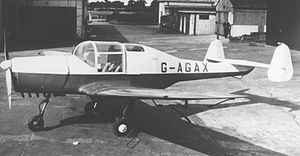Top speed 217 km/h Length 7.09 m First flight 1937 | Wingspan 11 m Retired 1988 Manufacturer General Aircraft Limited | |
 | ||
The General Aircraft GAL.42 Cygnet II was a 1930s British single-engined training or touring aircraft built by General Aircraft Limited at London Air Park, Hanworth.
Contents
History
The Cygnet was designed at Slough by C.W. Aircraft Limited in 1936. It was the first all-metal stressed-skin lightplane to be built and flown in the United Kingdom. It was first flown in May 1937 at London Air Park, Hanworth. Only one prototype was constructed by C.W. Aircraft. It had a tailwheel undercarriage. It had a low cantilever wing, the outer panel of which was tapered and had dihedral. Two persons sat side by side in an enclosed cabin. The metal airframe employed a semi-monocoque tailcone. Atop the tailcone sat a one-piece tailplane, with dual fins at the tailplane's ends. The inverted piston engine drove a two-blade propeller.
During that period C.W. Aircraft had invested heavily in another design, the C.W. Swan. Overextended, it became insolvent and sold all rights for the Cygnet to General Aircraft Ltd in 1938.
General Aircraft modified the design to incorporate a nosewheel undercarriage and designated it the GAL.42 Cygnet II. Production of a large batch of aircraft began in 1939 but only 10 were built and delivered (1939–1941) due to the start of the Second World War. Five aircraft were impressed into service with the Royal Air Force as tricycle-undercarriage trainers for aircrews slated to man the American-made Douglas Boston. Another two were used by the government for various liaison duties but retained their civilian markings.
A trainer version of the Cygnet II was designed with an open cockpit as the GAL.45 Owlet.
Surviving aircraft
There are two known survivors of the 11 examples produced. The last flying survivor, company number 111 and registered as G-AGBN (ES915), was retired in 1988 and is now on display at the National Museum of Flight at East Fortune, Scotland. It was a part of the Strathallan Collection owned by Sir William 'Willy' James Denby Roberts until the dissolution of the collection. The National Museum of Flight failed to acquire it but the bidding was taken over by Victor Gauntlett who donated to the museum.
A civilian version was operated in south Argentina, in Tierra del Fuego province where it was damaged in a landing incident. After being repaired and being flown for several years, it was landed at a short airstrip in Colón and was unable to depart therefrom. It remained there and subsequently was converted into a monument at the Air Club entrance. In 2008 it was reported to be in poor condition.
Military operators
Specifications
General characteristics
Performance
